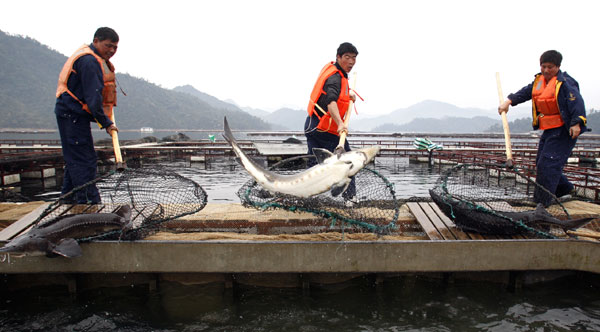A sector based on good taste
Updated: 2012-04-12 07:47
By Wu Wencong (China Daily)
|
||||||||
Chinese caviar's success shows tide is changing in its favor, reports Wu Wencong in Beijing.
April 8 was a red-letter day for conservationists. More than 1,200 farmed Chinese sturgeon were released into the Yangtze River to increase the numbers of this rare species in the wild. One of more than 20 species, the Chinese sturgeon, or acipenser sinensis, is unique to China and has existed for more than 140 million years. It enjoys protected status and it is illegal to breed or trade it privately, let alone have one on your dining table.
However, other types of sturgeon don't enjoy such revered status in China. They are cultivated commercially for their eggs, which are known as "roe" and can be processed into caviar, one of the most valuable foodstuffs in the world. Caviar bearing the label "A Product of China" has been available since 2006.
The international trade in sturgeon-related products once relied overwhelmingly on fish from the Caspian Sea, the world's largest lake, and accounted for about 93 percent of the global caviar trade in 2003, according to data released by the Convention on International Trade in Endangered Species of Wild Fauna and Flora.
However, overfishing, rampant poaching and environmental damage have sharply reduced the numbers of sturgeon in the Caspian in recent decades, forcing devotees to look elsewhere for their favorite dish.
"Ninety nine percent of the caviar traded in the global market now comes from farmed sturgeon," said Ni Hao, founder of Lindys Foodservice Consultant and former executive chef at the China division of Unilever's food solutions department.
Insiders say that China accounts for nearly 20 percent of the sturgeon in the global market, despite its relatively brief breeding history of less than 15 years, and the country's produce can now be found in Europe, the US and Japan. It's become a stable supplier of high-end brands such as "Petrossian" of France and can also be found in the first-class cabins of international airlines.
Although China is a relative newcomer to the world of caviar production, the prices of the product culled from certain types of sturgeon are higher than those of many foreign counterparts because, unlike the majority of rivals, sturgeon in China are mainly raised in natural waters rather than the recycled variety prevalent in fish farms, leading to larger fish and bigger eggs.
"Water is a very important factor in determining the quality of caviar," said Ni. "It may taste too earthy if the water used is not of high enough quality. Larger eggs normally mean higher prices," said the 39-year-old expert.

 Relief reaches isolated village
Relief reaches isolated village
 Rainfall poses new threats to quake-hit region
Rainfall poses new threats to quake-hit region
 Funerals begin for Boston bombing victims
Funerals begin for Boston bombing victims
 Quake takeaway from China's Air Force
Quake takeaway from China's Air Force
 Obama celebrates young inventors at science fair
Obama celebrates young inventors at science fair
 Earth Day marked around the world
Earth Day marked around the world
 Volunteer team helping students find sense of normalcy
Volunteer team helping students find sense of normalcy
 Ethnic groups quick to join rescue efforts
Ethnic groups quick to join rescue efforts
Most Viewed
Editor's Picks

|

|

|

|

|

|
Today's Top News
Health new priority for quake zone
Xi meets US top military officer
Japan's boats driven out of Diaoyu
China mulls online shopping legislation
Bird flu death toll rises to 22
Putin appoints new ambassador to China
Japanese ships blocked from Diaoyu Islands
Inspired by Guan, more Chinese pick up golf
US Weekly

|

|







